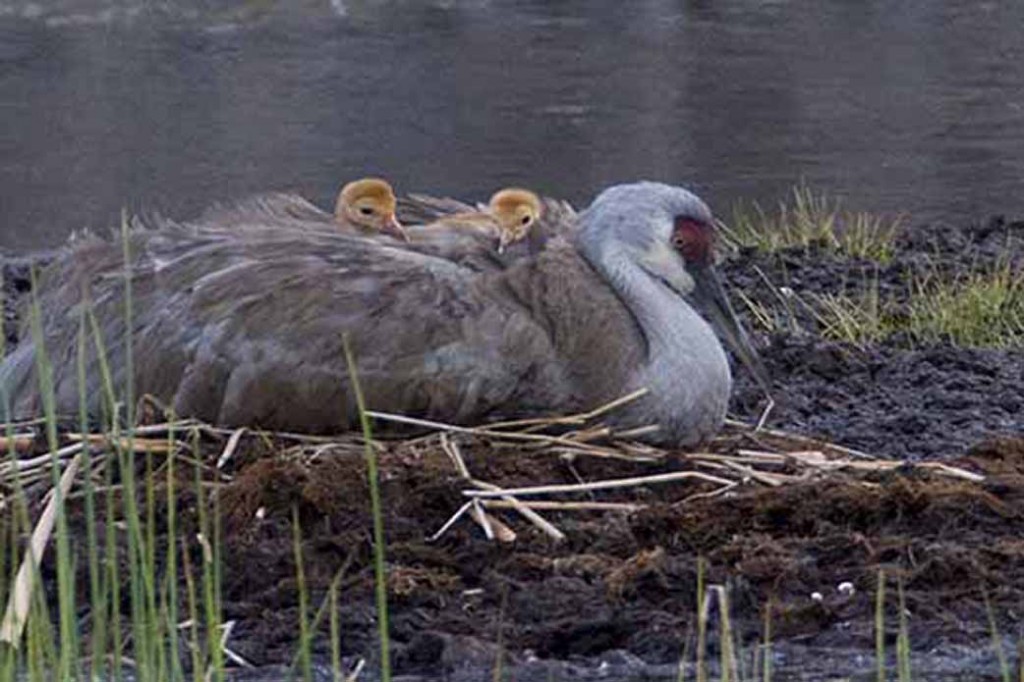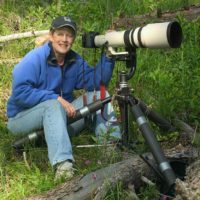
“Do you need a lot of patience to be a wildlife photographer?” I have heard that question a jillion times, and the answer is good news and bad news. You do need patience — and a lot of it. Fortunately, patience can be developed or learned. Sometimes a super image materializes right before your eyes and you barely have time to shoot one frame. Usually though, you have to rely on your skills as a naturalist and “intel” from various sources just to have some idea where to start to look.
For this image, it took both patience and knowing a little about the habits and routines of Yellowstone sandhill cranes. In Yellowstone National Park, there is a little lake right along the upper loop road — between Tower Junction and Mammoth — called Floating Island Lake. It is a great place to see lots of different kinds of wildlife, but there are almost always sandhill cranes there in the spring. (A good thing to keep in mind!) The cranes build a nest on a little island on the lake.
Once the colts (baby cranes) hatch, the adults swim with them over to the shore and show them what to eat and where to find it. The whole family will spend the day on the shore, working back and forth looking for bugs and frogs. At this point, they are pretty far from the road, and most lenses, even the big ones, won’t reach that far.
But in the evening, the family of Yellowstone sandhill cranes swims back to the island, within camera range. One adult beds down and the other stands guard. The colts immediately start to jockey with each other for the best downy spot under the adult’s wings to spend the night. It takes them maybe 20 minutes or so, and they are very comical in their negotiations. In and out, in and out, round about the adult, over and over again. Finally, they find their spot and settle down.
Hopefully, when the Yellowstone sandhill cranes have settled down, there is still enough light left in the day to shoot. You might have to boost your camera’s ISO (light sensitivity) setting, because of less light. But if you wait for them to be still, you won’t need to adjust the ISO to prevent the action from blurring. If there is not enough light, even with a boost in your ISO, there is always tomorrow! Patience, patience, remember?

It took patience and perseverance to get this shot of Yellowstone sandhill cranes. But I don’t think this behavior is unique to the birds at Floating Island. Anywhere you find cranes that have nested and have young colts, you will find this behavior. Floating Island is ideal because these Yellowstone sandhill cranes feel secure on their island, and there are few weeds, cattails or the like in the way between you and the birds. If you look, you will find other suitable places as well.
Please always respect the space these birds need to nest and live. If you don’t, you may force them to act in way that they wouldn’t otherwise, exposing them to predators and other dangers just because you pushed too hard. Besides, if you push too hard, you won’t get the shot either, because they will take off!
 Meg Sommers is a wildlife and nature photographer who also works as an attorney and part-time judge in Cody, Wyo. She teaches a wildlife photography course in Yellowstone Park for the Yellowstone Association Institute.
Meg Sommers is a wildlife and nature photographer who also works as an attorney and part-time judge in Cody, Wyo. She teaches a wildlife photography course in Yellowstone Park for the Yellowstone Association Institute.
How I Got That Shot takes you behind the scenes to learn how a top Yellowstone or Grand Teton photographer captured a terrific image. If you have a great shot you’d like to share, please send it to [email protected].
